Samsung G715FN-DS Service Manual

USER MANUAL
SM-G715FN
SM-G715FN/DS
English (EU). 01/2020. Rev.1.1 |
www.samsung.com |
Table of Contents
Basics |
72 |
Contacts |
||
4 |
Read me first |
76 |
Messages |
|
79 |
Internet |
|||
7 |
Device overheating situations and |
|||
81 |
Camera |
|||
|
solutions |
|||
|
98 |
Gallery |
||
10 |
Device layout and functions |
|||
103 |
AR EMOJI |
|||
14 |
Battery |
|||
110 |
AR Doodle |
|||
18 |
SIM or USIM card (nano-SIM card) |
|||
111 |
Multi window |
|||
21 |
Memory card (microSD card) |
|||
114 |
Samsung Pay |
|||
22 |
Turning the device on and off |
|||
117 |
Samsung Health |
|||
24 |
Initial setup |
|||
120 |
Samsung Members |
|||
25 |
Samsung account |
|||
120 |
Samsung Notes |
|||
27 |
Transferring data from your previous |
|||
|
device (Smart Switch) |
121 |
Galaxy Wearable |
|
29 |
Understanding the screen |
121 |
Calendar |
|
42 |
Notification panel |
123 |
Radio |
|
44 |
Entering text |
124 |
Voice Recorder |
|
|
|
125 |
My Files |
|
Apps and features |
125 |
Clock |
||
127 |
Calculator |
|||
48 |
Installing or uninstalling apps |
127 |
Game Launcher |
|
50 |
Finder |
129 |
Game Booster |
|
50 |
Bixby |
130 |
Kids Home |
|
54 |
Bixby Vision |
132 |
SmartThings |
|
57 |
Bixby Home |
136 |
Sharing content |
|
60 |
Bixby Routines |
137 |
Samsung Global Goals |
|
63 |
Reminder |
137 |
Google apps |
|
67 |
Phone |
|
|
|
2

Table of Contents
Settings
139 Introduction
139Connections 140 Wi-Fi
142 Bluetooth
144 NFC and payment
146 Data saver
146 Mobile data only apps
147SIM card manager (dual SIM models)
147 Mobile Hotspot and Tethering
149 More connection settings
151Sounds and vibration
151 Dolby Atmos (surround sound)
152 Separate app sound
152Notifications
153Display
154 Dark mode
154 Screensaver
155Wallpaper
155Themes
155Lock screen 156 Smart Lock
156Biometrics and security 157 Face recognition
160 Fingerprint recognition
163 Samsung Pass
166 Secure Folder
171Privacy
171Location
172Accounts and backup 172 Samsung Cloud
174 Google
174Advanced features 175 Link to Windows
176 Motions and gestures
177 Dual Messenger
178Digital Wellbeing and parental controls
178 Digital Wellbeing
180 Device care
180Optimising your device
181Battery
182Storage
182 Memory
182 Security
183 Apps
183General management
184Accessibility
185Software update
185 About phone
Appendix
186 Troubleshooting
3
Basics
Read me first
Please read this manual before using the device to ensure safe and proper use.
•Descriptions are based on the device’s default settings.
•Some content may differ from your device depending on the region, service provider, model specifications, or device’s software.
•Content (high quality content) that requires high CPU and RAM usage will affect the overall performance of the device. Apps related to the content may not work properly depending on the device’s specifications and the environment that it is used in.
•Samsung is not liable for performance issues caused by apps supplied by providers other than Samsung.
•Samsung is not liable for performance issues or incompatibilities caused by edited registry settings or modified operating system software. Attempting to customise the operating system may cause the device or apps to work improperly.
•Software, sound sources, wallpapers, images, and other media provided with this device are licensed for limited use. Extracting and using these materials for commercial or other purposes is an infringement of copyright laws. Users are entirely responsible for illegal use of media.
•You may incur additional charges for data services, such as messaging, uploading and downloading, auto-syncing, or using location services depending on your data plan. For large data transfers, it is recommended to use the Wi-Fi feature.
•Default apps that come with the device are subject to updates and may no longer be supported without prior notice. If you have questions about an app provided with the device, contact a Samsung Service Centre. For user-installed apps, contact service providers.
4

Basics
•Modifying the device’s operating system or installing softwares from unofficial sources may result in device malfunctions and data corruption or loss. These actions are violations of your Samsung licence agreement and will void your warranty.
•Depending on the region or service provider, a screen protector is attached for protection during production and distribution. Damage to the attached screen protector is not covered by the warranty.
•You can see the touchscreen clearly even in strong outdoor sunlight by automatically adjusting the contrast range based on the surrounding environment. Due to the nature of the product, displaying fixed graphics for extended periods may result in afterimages (screen burn-in) or ghosting.
––It is recommended not to use fixed graphics on part or all of the touchscreen for extended periods and turn off the touchscreen when not using the device.
––You can set the touchscreen to turn off automatically when you are not using it. Launch the Settings app, tap Display →Screen timeout, and then select the length of time you want the device to wait before turning off the touchscreen.
––To set the touchscreen to automatically adjust its brightness based on the surrounding environment, launch the Settings app, tap Display, and then tap the Adaptive brightness switch to activate it.
•Depending on the region, you can view the regulatory information on the device. To view the information, launch the Settings app and tap About phone →Regulatory information.
Maintaining water and dust resistance
Your device supports waterand dust-resistance. Follow these tips carefully to maintain the waterand dust-resistance of your device. Failure to do so may result in damage to your device.
•Do not immerse the device in fresh water deeper than 1.5 m or keep it submerged for more than 30 minutes. If you immerse the device in any liquid other than fresh water, such as salt water, ionised water, or alcoholic beverage, liquid will enter the device faster.
•Do not expose the device to water moving with force.
5

Basics
•Do not open the device’s covers when the device is in water or in very humid places, such as swimming pools or bathrooms.
•Do not open the back cover using wet hands or when the device is wet.
•The rubber seal fitted to the back cover is an important component of the device. Take care when opening and closing the back cover to avoid damaging the rubber seal. Also, ensure that the rubber seal is free from debris, such as sand or dust to prevent damage to the device.
•The back cover may be loosened if the device is dropped or receives an impact. Ensure that all the covers are properly aligned and tightly closed.
•If the device is exposed to fresh water, dry it thoroughly with a clean, soft cloth. If the device is exposed to other liquids, such as salt water, swimming pool water, soapy water, oil, perfume, sunscreen, hand cleaner, or chemical products such as cosmetics, rinse it with fresh water and dry it thoroughly with a clean, soft cloth. If you do not follow these instructions, the device’s performance and appearance may be affected.
•If the device has been immersed in water or the microphone or speaker is wet, sound may not be heard clearly during a call. After wiping the device with a dry cloth, dry it thoroughly before using it.
•The touchscreen and other features may not work properly if the device is used in water.
•Your device has been tested in a controlled environment and certified to be waterand dust-resistant in specific situations (meets requirements of classification IP68 as described by the international standard IEC 60529-Degrees of Protection provided by Enclosures [IP Code]; test conditions: 15-35 °C, 86-106 kPa, fresh water, 1.5 metre, 30 minutes). Despite this classification, it is still possible for your device to be damaged in certain situations.
Instructional icons
Warning: situations that could cause injury to yourself or others
Caution: situations that could cause damage to your device or other equipment
Notice: notes, usage tips, or additional information
6

Basics
Device overheating situations and solutions
When the device heats up while charging the battery
While charging, the device and the charger may become hot. During wireless charging or fast charging, the device may feel hotter to the touch. This does not affect the device’s lifespan or performance and is in the device’s normal range of operation. If the battery becomes too hot, the charger may stop charging.
Do the following when the device heats up:
•Disconnect the charger from the device and close any running apps. Wait for the device to cool down and then begin charging the device again.
•If the lower part of the device overheats, it could be because the connected USB cable is damaged. Replace the damaged USB cable with a new Samsung-approved one.
•When using a wireless charger, do not place foreign materials, such as metal objects, magnets, and magnetic stripe cards, between the device and the wireless charger.
The wireless charging or fast charging feature is only available on supported models.
When the device heats up during use
When you use features or apps that require more power or use them for extended periods, your device may temporarily heat up due to increased battery consumption. Close any running apps and do not use the device for a while.
The following are examples of situations in which the device may overheat. Depending on the functions and apps you use, these examples may not apply to your model.
•During the initial setup after purchase or when restoring data
•When downloading large files
•When using apps that require more power or using apps for extended periods
––When playing high-quality games for extended periods
––When recording videos for extended periods
7

Basics
––When streaming videos while using the maximum brightness setting
––When connecting to a TV
•While multitasking (or, when running many apps in the background)
––When using Multi window
––When updating or installing apps while recording videos
––When downloading large files during a video call
––When recording videos while using a navigation app
•When using large amount of data for syncing with the cloud, email, or other accounts
•When using a navigation app in a car while the device is placed in direct sunlight
•When using the mobile hotspot and tethering feature
•When using the device in areas with weak signals or no reception
•When charging the battery with a damaged USB cable
•When the device’s multipurpose jack is damaged or exposed to foreign materials, such as liquid, dust, metal powder, and pencil lead
•When you are roaming
Do the following when the device heats up:
•Keep the device updated with the latest software.
•Conflicts between running apps may cause the device to heat up. Restart the device.
•Deactivate the Wi-Fi, GPS, and Bluetooth features when not using them.
•Close apps that increase battery consumption or that run in the background when not in use.
•Delete unnecessary files or unused apps.
•Decrease the screen brightness.
•If the device overheats or feels hot for a prolonged period, do not use it for a while. If the device continues to overheat, contact a Samsung Service Centre.
8

Basics
Precautions for device overheating
If you begin to feel uncomfortable due to the device overheating, stop using the device.
When the device heats up, the features and performance may be limited or the device may turn off to cool down. The feature is only available on supported models.
•If the device overheats and reaches a certain temperature, a warning message will appear to prevent device failure, skin irritations and damages, and battery leakage. To lower the device’s temperature, the screen brightness and the performance speed will be limited and battery charging will stop. Running apps will be closed and all calling and other features will be limited, except for emergency calls, until the device cools down.
•If the second message appears due to a further increase of the device’s temperature, the device will turn off. Do not use the device until the device’s temperature drops below the specified level. If the second warning message appears during an emergency call, the call will not be disconnected by a forced shut down.
Precautions for operating environment
Your device may heat up due to the environment in the following conditions. Use caution to avoid shortening the battery’s lifespan, damaging the device, or causing a fire.
•Do not store your device in very cold or very hot temperatures.
•Do not expose your device to direct sunlight for extended periods.
•Do not use or store your device for extended periods in very hot areas, such as inside a car in the summertime.
•Do not place the device in any areas that may overheat, such as on an electric heating mat.
•Do not store your device near or in heaters, microwaves, hot cooking equipment, or high pressure containers.
•Do not use a cable whose covering is peeled off or damaged, and do not use any charger or battery that is damaged or malfunctioning.
9

Basics
Device layout and functions
Package contents
Refer to the quick start guide for package contents.
•The items supplied with the device and any available accessories may vary depending on the region or service provider.
•The supplied items are designed only for this device and may not be compatible with other devices.
•Appearances and specifications are subject to change without prior notice.
•You can purchase additional accessories from your local Samsung retailer. Make sure they are compatible with the device before purchase.
•Use only Samsung-approved accessories. Using unapproved accessories may cause the performance problems and malfunctions that are not covered by the warranty.
•Availability of all accessories is subject to change depending entirely on manufacturing companies. For more information about available accessories, refer to the Samsung website.
10
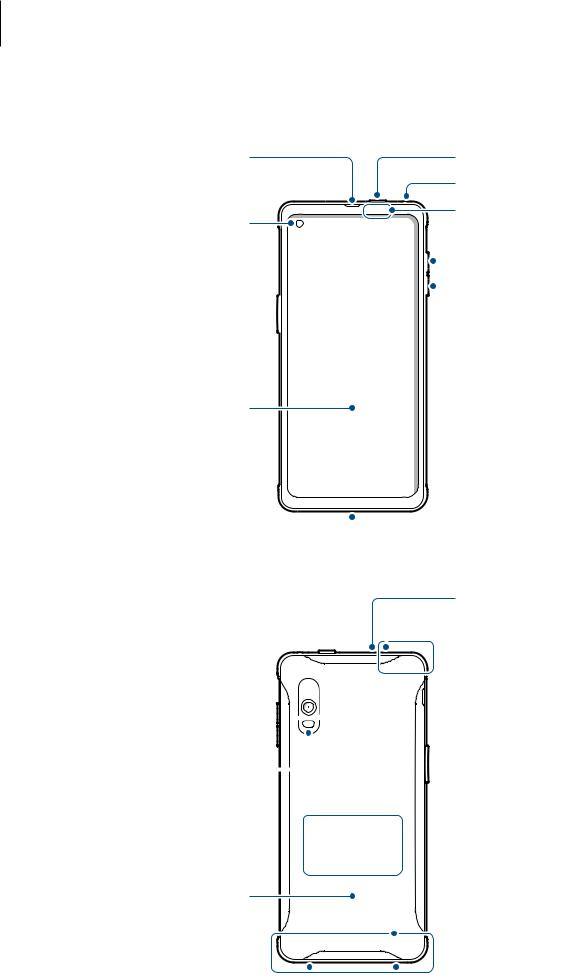
Basics
Device layout
Speaker |
Top key |
|
LED indicator |
Front camera |
Proximity sensor |
|
XCover key 

Touchscreen
Multipurpose jack (USB Type-C)
(USB Type-C)
Rear camera (Dual) 

Flash 
Back cover
Speaker

 Volume key
Volume key
 Side key (Power/Bixby/Fingerprint recognition sensor)
Side key (Power/Bixby/Fingerprint recognition sensor)
Earphone jack
 Microphone
Microphone
 GPS antenna
GPS antenna
 NFC antenna (on the battery)
NFC antenna (on the battery)
 Main antenna
Main antenna
 Microphone
Microphone
11
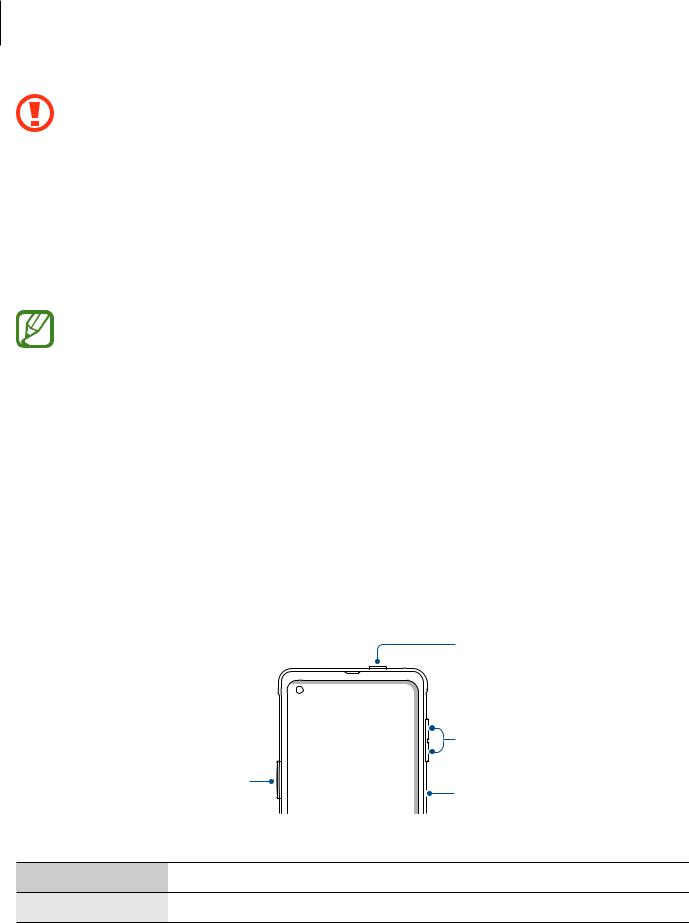
Basics
• When using the speakers, such as when playing media files or using speakerphone, do not place the device close to your ears.
•Be careful not to expose the camera lens to a strong light source, such as direct sunlight. If the camera lens is exposed to a strong light source, such as direct sunlight, the camera image sensor may be damaged. A damaged image sensor is irreparable and will cause dots or spots in pictures.
•If you use the device with its glass or acrylic body broken, there may be a risk of injury. Use the device only after it has been repaired at a Samsung Service Centre.
•Connectivity problems and battery drain may occur in the following situations:
––If you attach metallic stickers on the antenna area of the device
––If you attach a device cover made with metallic material to the device
––If you cover the device’s antenna area with your hands or other objects while using certain features, such as calls or the mobile data connection
•Using a Samsung-approved screen protector is recommended. Unapproved screen protectors may cause the sensors to malfunction.
•Do not cover the proximity sensor area with screen accessories, such as a screen protector, stickers, or a cover. Doing so may cause the sensor to malfunction.
Hard keys
|
|
Top key |
|
|
Volume key |
|
XCover key |
Side key |
|
|
|
|
|
(Power/Bixby/Fingerprint |
|
|
recognition sensor) |
Key |
Function |
|
Volume key |
• Press to adjust the device volume. |
|
12

Basics
Key |
Function |
|
|
• |
When the device is off, press and hold to turn it on. |
|
• |
Press to turn on or lock the screen. |
Side key |
• |
Press and hold to start a conversation with Bixby. Refer to Using |
|
Bixby for more information. |
|
|
|
|
|
• |
Press twice or press and hold to launch the app or feature you set. |
|
• |
Place your finger on the Side key to register your fingerprints. |
Side key + |
• |
Press simultaneously to capture a screenshot. |
Volume Down key |
• |
Press and hold simultaneously to turn off the device. |
|
|
|
XCover key |
• |
Press or press and hold to launch preset apps. |
|
|
|
Top key |
• |
Press or press and hold to launch preset apps. |
|
|
|
Setting the Side key
Select an app or feature to launch by pressing the Side key twice or pressing and holding the Side key.
Launch the Settings app, tap Advanced features →Side key, and then select an option you want.
Soft buttons
Recents button |
Back button |
|
Home button |
When you turn on the screen, the soft buttons will appear at the bottom of the screen. The soft buttons are set to the Recents button, Home button, and Back button by default. Refer to Navigation bar (soft buttons) for more information.
13
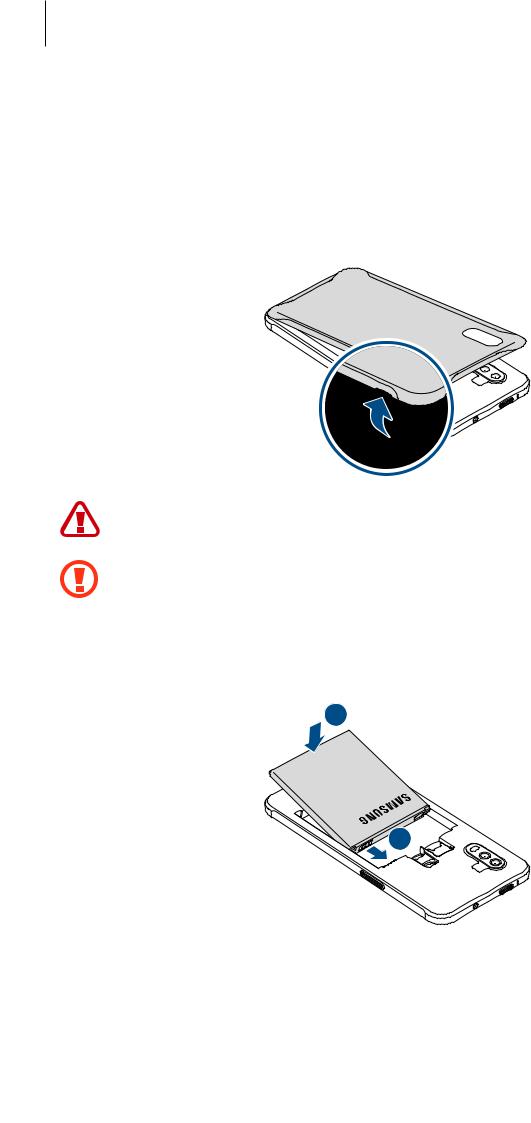
Basics
Battery
Installing the battery
1 Remove the back cover.
Be careful not to damage your fingernails when you remove the back cover.
Do not bend or twist the back cover excessively. Doing so may damage the cover.
2 Insert the battery with the battery’s gold-coloured contacts properly aligned with the device’s contacts.
2
1
14
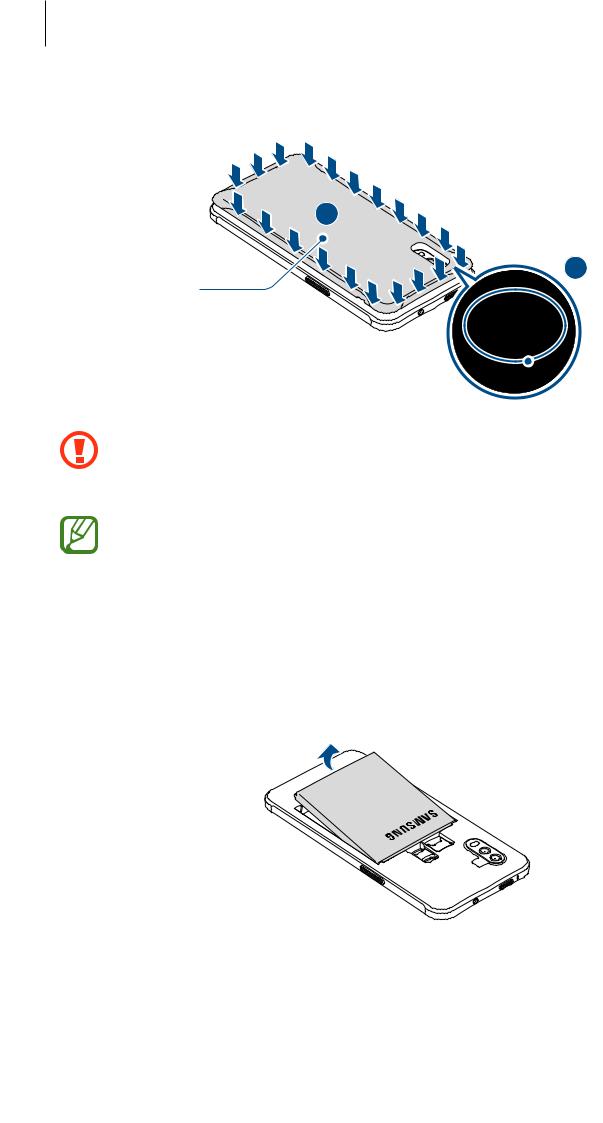
Basics
3 Replace the back cover.
2 |
Press
 Align
Align
Ensure that the back cover is closed tightly to prevent water and dust from entering the device. Open or loose back cover may allow water and dust to enter the device and cause damage.
Use only Samsung-approved back covers and accessories with the device.
Removing the battery
1
2
Remove the back cover.
Pull out the battery.
15
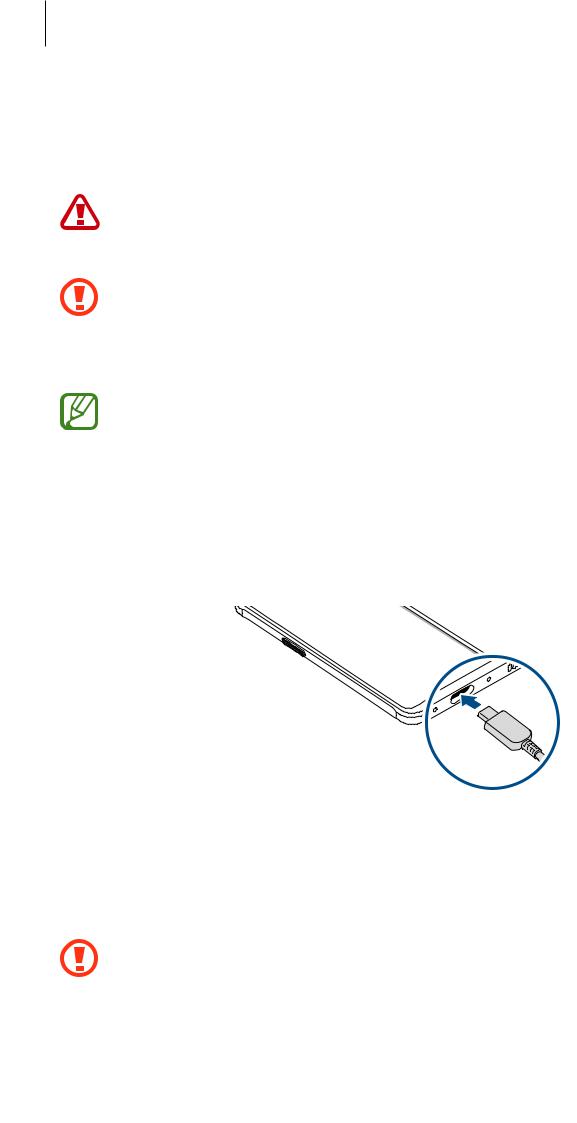
Basics
Charging the battery
Charge the battery before using it for the first time or when it has been unused for extended periods.
Use only Samsung-approved battery, charger, and cable specifically designed for your device. Incompatible battery, charger, and cable can cause serious injuries or damage to your device.
1
2
3
4
•Connecting the charger improperly may cause serious damage to the device. Any damage caused by misuse is not covered by the warranty.
•Use only USB Type-C cable supplied with the device. The device may be damaged if you use Micro USB cable.
To save energy, unplug the charger when not in use. The charger does not have a power switch, so you must unplug the charger from the electric socket when not in use to avoid wasting power. The charger should remain close to the electric socket and easily accessible while charging.
Connect the USB cable to the USB power adaptor.
Plug the USB cable into the device’s multipurpose jack.
Plug the USB power adaptor into an electric socket.
After fully charging, disconnect the charger from the device. Then, unplug the charger from the electric socket.
Do not remove the battery before removing the charger. This may damage the device.
16

Basics
Reducing the battery consumption
Your device provides various options that help you conserve battery power.
•Optimise the device using the device care feature.
•When you are not using the device, turn off the screen by pressing the Side key.
•Activate power saving mode.
•Close unnecessary apps.
•Deactivate the Bluetooth feature when not in use.
•Deactivate auto-syncing of apps that need to be synced.
•Decrease the backlight time.
•Decrease the screen brightness.
Battery charging tips and precautions
•When the battery power is low, the battery icon appears empty.
•If the battery is completely discharged, the device cannot be turned on immediately when the charger is connected. Allow a depleted battery to charge for a few minutes before turning on the device.
•If you use multiple apps at once, network apps, or apps that need a connection to another device, the battery will drain quickly. To avoid losing power during a data transfer, always use these apps after fully charging the battery.
•Using a power source other than the charger, such as a computer, may result in a slower charging speed due to a lower electric current.
•The device can be used while it is charging, but it may take longer to fully charge the battery.
•If the device receives an unstable power supply while charging, the touchscreen may not function. If this happens, unplug the charger from the device.
•While charging, the device and the charger may heat up. This is normal and should not affect the device’s lifespan or performance. If the battery gets hotter than usual, the charger may stop charging. If this occurs during wireless charging, disconnect the device from the charger to let it cool down, then charge the device again later.
•If you charge the device while the multipurpose jack is wet, the device may be damaged. Thoroughly dry the multipurpose jack before charging the device.
•If the device is not charging properly, take the device and the charger to a Samsung Service Centre.
17

Basics
Fast charging
The device has a built-in fast charging feature. You can charge the battery more quickly while the device or its screen is turned off.
Increasing the charging speed
To increase the charging speed, turn the device or its screen off when you charge the battery.
If the fast charging feature is not activated, launch the Settings app, tap Device care → Battery, and then tap the Fast cable charging switch to activate it.
•While charging, you cannot activate or deactivate this feature.
•You cannot use the built-in fast charging feature when you charge the battery using a standard battery charger.
•If the device heats up or the ambient air temperature rises, the charging speed may decrease automatically. This is a normal operating condition to prevent damage to the device.
SIM or USIM card (nano-SIM card)
Installing the SIM or USIM card
Insert the SIM or USIM card provided by the mobile telephone service provider.
For dual SIM models, you can insert two SIM or USIM cards so you can have two phone numbers or service providers for a single device. In some areas, data transfer speeds may be slower if two SIM cards are inserted in the device than when one SIM card is inserted.
|
• |
Use only a nano-SIM card. |
|
• |
Use caution not to lose or let others use the SIM or USIM card. Samsung is not |
|
||
|
||
|
|
responsible for any damages or inconveniences caused by lost or stolen cards. |
Some services that require a network connection may not be available depending on the service provider.
18
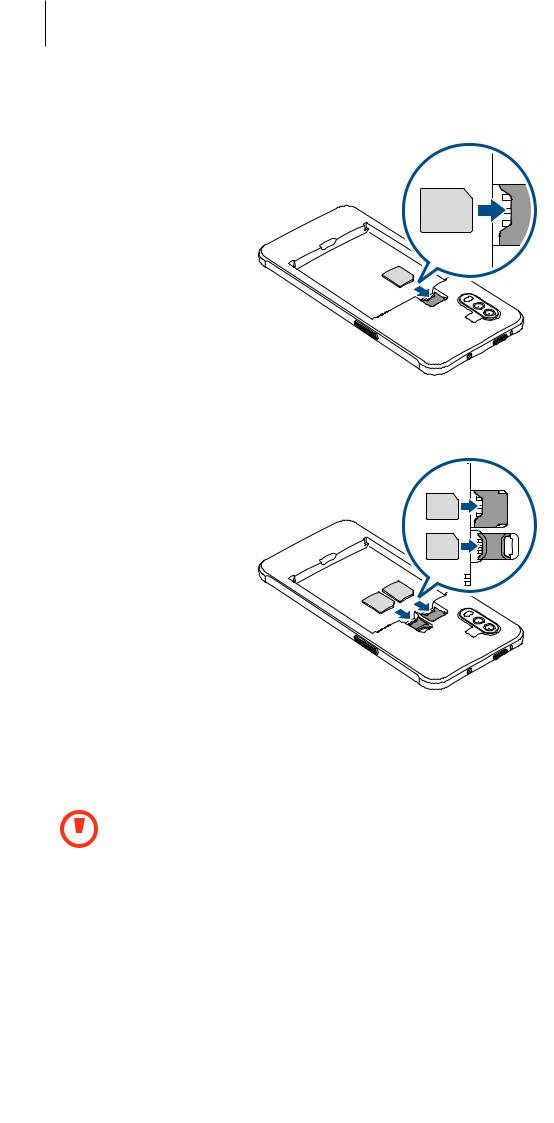
Basics
►Single SIM models:
►Dual SIM models:
1 |
Remove the back cover and battery. |
|
2 |
Insert the SIM or USIM card with the gold-coloured contacts facing downwards. |
|
|
|
Do not insert a memory card into the SIM card slot. If a memory card happens to be |
|
|
lodged in the SIM card slot, take the device to a Samsung Service Centre to remove |
|
|
|
|
|
|
|
|
the memory card. |
3 |
Replace the battery and back cover. |
|
19

Basics
Using dual SIM or USIM cards (dual SIM models)
If you insert two SIM or USIM cards, you can have two phone numbers or service providers for a single device.
Activating SIM or USIM cards
Launch the Settings app and tap Connections →SIM card manager. Select a SIM or USIM card and tap the switch to activate it.
Customising SIM or USIM cards
Launch the Settings app, tap Connections →SIM card manager, and then select a SIM or USIM card to access the following options:
•Icon: Change the icon of the SIM or USIM card.
•Name: Change the display name of the SIM or USIM card.
•Network mode: Select a network type to use with the SIM or USIM card.
Setting preferred SIM or USIM cards
When two cards are activated, you can assign voice calls, messaging, and data services to specific cards.
Launch the Settings app, tap Connections →SIM card manager, and then set the feature preferences for your cards in Preferred SIM card.
20
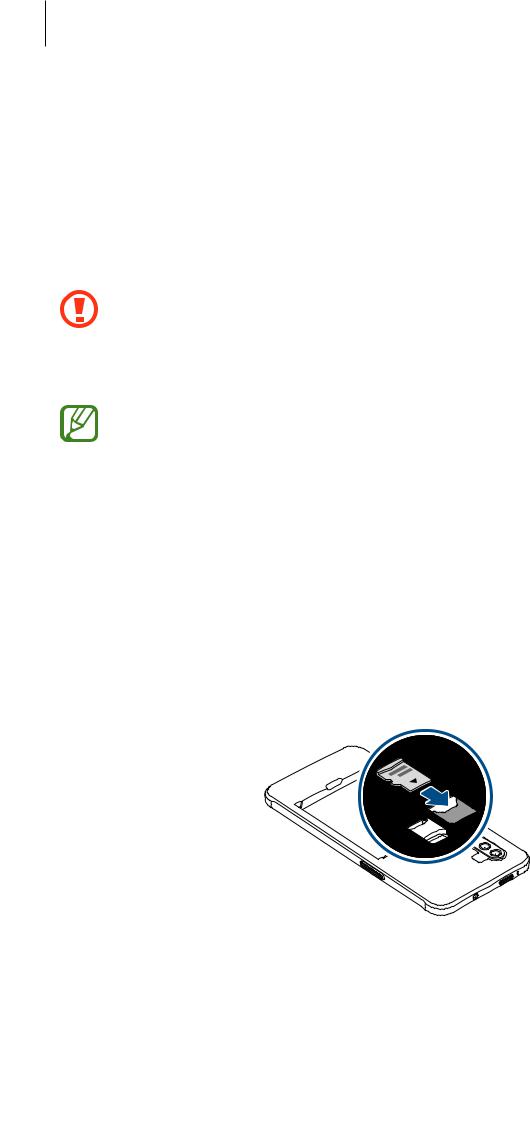
Basics
Memory card (microSD card)
Installing a memory card
Your device’s memory card capacity may vary from other models and some memory cards may not be compatible with your device depending on the memory card manufacturer and type. To view your device’s maximum memory card capacity, refer to the Samsung website.
1
2
•Some memory cards may not be fully compatible with the device. Using an incompatible card may damage the device or the memory card, or corrupt the data stored in it.
•Use caution to insert the memory card right-side up.
•The device supports the FAT and the exFAT file systems for memory cards. When inserting a card formatted in a different file system, the device will ask to reformat the card or will not recognise the card. To use the memory card, you must format it. If your device cannot format or recognise the memory card, contact the memory card manufacturer or a Samsung Service Centre.
•Frequent writing and erasing of data shortens the lifespan of memory cards.
•When inserting a memory card into the device, the memory card’s file directory appears in the My Files →SD card folder.
Remove the back cover and battery.
Insert a memory card with the gold-coloured contacts facing downwards.
3 Replace the battery and back cover.
21

Basics
Removing the memory card
Before removing the memory card, first unmount it for safe removal.
Launch the Settings app and tap Device care →Storage →Advanced →SD card → Unmount.
Do not remove external storage, such as a memory card or USB storage, while the device is transferring or accessing information, or right after transferring data. Doing so can cause data to be corrupted or lost or cause damage to the external storage or device. Samsung is not responsible for losses, including loss of data, resulting from the misuse of external storage devices.
Formatting the memory card
A memory card formatted on a computer may not be compatible with the device. Format the memory card on the device.
Launch the Settings app and tap Device care →Storage →Advanced →SD card → Format.
Before formatting the memory card, remember to make backup copies of all important data stored in the memory card. The manufacturer’s warranty does not cover loss of data resulting from user actions.
Turning the device on and off
Follow all posted warnings and directions from authorised personnel in areas where the use of wireless devices is restricted, such as aeroplanes and hospitals.
Turning the device on
Press and hold the Side key for a few seconds to turn on the device.
When you turn on your device for the first time or after performing a data reset, follow the on-screen instructions to set up your device.
22
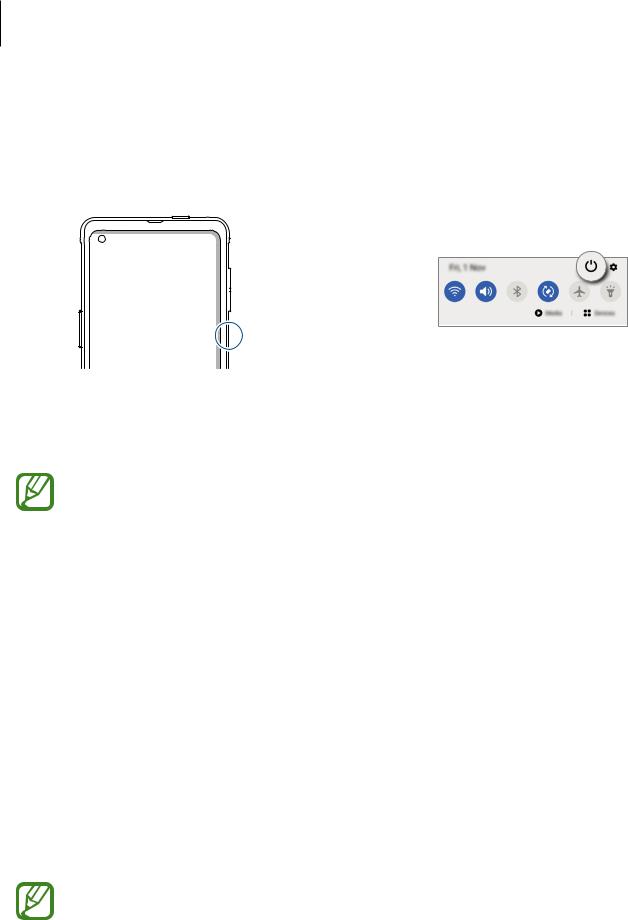
Basics
Turning the device off
1 To turn off the device, press and hold the Side key and the Volume Down key simultaneously. Alternatively, open the notification panel and tap  .
.
 Volume Down key
Volume Down key
 Side key
Side key
2 Tap Power off.
To restart the device, tap Restart.
You can set the device to turn off when you press and hold the Side key. Launch the
Settings app, tap Advanced features →Side key, and then tap Power off menu under Press and hold.
Forcing restart
If your device is frozen and unresponsive, press and hold the Side key and the Volume Down key simultaneously for more than 7 seconds to restart it.
Emergency mode
You can switch the device to emergency mode to reduce battery consumption. Some apps and functions will be restricted. In emergency mode, you can make an emergency call, send your current location information to others, sound an emergency alarm, and more.
To activate emergency mode, press and hold the Side key and the Volume Down key simultaneously. Alternatively, open the notification panel and tap  →Emergency mode.
→Emergency mode.
To deactivate emergency mode, tap  →Turn off Emergency mode.
→Turn off Emergency mode.
The usage time left shows the time remaining before the battery power runs out. Usage time left may vary depending on your device settings and operating conditions.
23

Basics
Initial setup
When you turn on your device for the first time or after performing a data reset, follow the on-screen instructions to set up your device.
1
2
Press and hold the Side key for a few seconds to turn on the device.
Select your preferred device language and select  .
.
Select a language. 
3 Follow the on-screen instructions to complete the setup.
The Home screen will appear.
If you do not connect to a Wi-Fi network, you may not be able to set up some device features during the initial setup.
24

Basics
Samsung account
Your Samsung account is an integrated account service that allows you to use a variety of Samsung services provided by mobile devices, TVs, and the Samsung website.
To check the list of services that can be used with your Samsung account, visit account.samsung.com. For more information on Samsung accounts, launch the Settings app and tap Accounts and backup →Accounts →Samsung account → →Help.
→Help.
Creating a Samsung account
If you do not have a Samsung account, you should create one. You can create a Samsung account using your email address.
1
2
3
Launch the Settings app and tap Accounts and backup →Accounts →Add account → Samsung account.
Alternatively, launch the Settings app and tap  .
.
Tap Create account.
Follow the on-screen instructions to complete creating your account.
25

Basics
Signing in to your Samsung account
If you already have a Samsung account, sign in to your Samsung account.
1
2
3
Launch the Settings app and tap Accounts and backup →Accounts →Add account → Samsung account.
Alternatively, launch the Settings app and tap  .
.
Enter your Samsung account ID and password and tap Sign in.
Follow the on-screen instructions to complete signing in to your Samsung account.
Finding your ID and resetting your password
If you forget your Samsung account ID or password, tap Find ID or Reset password on the Samsung account sign-in screen. You can find your ID or reset your password after you enter the required information.
Removing your Samsung account
When you remove your Samsung account from the device, your data, such as contacts or events, will also be removed.
1 |
Launch the Settings app and tap Accounts and backup →Accounts. |
2 |
Tap Samsung account →Personal info → →Remove account. |
3 |
Tap Remove, enter your Samsung account password, and then tap OK. |
26

Basics
Transferring data from your previous device (Smart Switch)
You can use Smart Switch to transfer data from your previous device to your new device. Launch the Settings app and tap Accounts and backup →Smart Switch.
•This feature may not be supported on some devices or computers.
•Limitations apply. Visit www.samsung.com/smartswitch for details. Samsung takes copyright seriously. Only transfer content that you own or have the right to transfer.
Transferring data wirelessly
Transfer data from your previous device to your device wirelessly via Wi-Fi Direct.
1 |
On the previous device, launch Smart Switch. |
|
If you do not have the app, download it from Galaxy Store or Play Store. |
2 |
On your device, launch the Settings app and tap Accounts and backup →Smart |
|
Switch. |
3
4
5
6
Place the devices near each other.
On the previous device, tap Send data →Wireless.
On your device, select an item to bring and tap Transfer.
Follow the on-screen instructions to transfer data from your previous device.
27

Basics
Backing up and restoring data using external storage
Transfer data using external storage, such as a microSD card.
1
2
3
Back up data from your previous device to external storage.
Insert or connect the external storage device to your device.
On your device, launch the Settings app and tap Accounts and backup →Smart Switch → →Restore.
→Restore.
4 Follow the on-screen instructions to transfer data from external storage.
Transferring backup data from a computer
Transfer data between your device and a computer. You must download the Smart Switch computer version app from www.samsung.com/smartswitch. Back up data from your previous device to a computer and import the data to your device.
1
2
On the computer, visit www.samsung.com/smartswitch to download Smart Switch.
On the computer, launch Smart Switch.
If your previous device is not a Samsung device, back up data to a computer using a program provided by the device’s manufacturer. Then, skip to the fifth step.
3
4
Connect your previous device to the computer using the device’s USB cable.
On the computer, follow the on-screen instructions to back up data from the device. Then, disconnect your previous device from the computer.
5
6
Connect your device to the computer using the USB cable.
On the computer, follow the on-screen instructions to transfer data to your device.
28

Basics
Understanding the screen
Controlling the touchscreen
• Do not allow the touchscreen to come into contact with other electrical devices. Electrostatic discharges can cause the touchscreen to malfunction.
•To avoid damaging the touchscreen, do not tap it with anything sharp or apply excessive pressure to it with your fingertips.
•It is recommended not to use fixed graphics on part or all of the touchscreen for extended periods. Doing so may result in afterimages (screen burn-in) or ghosting.
•The device may not recognise touch inputs close to the edges of the screen, which are outside of the touch input area.
•It is recommended to use fingers when you use the touchscreen.
Tapping
Tap the screen.
Tapping and holding
Tap and hold the screen for approximately 2 seconds.
29

Basics
Dragging
Tap and hold an item and drag it to the target position.
Double-tapping
Double-tap the screen.
Swiping
Swipe upwards, downwards, to the left, or to the right.
Spreading and pinching
Spread two fingers apart or pinch on the screen.
30
